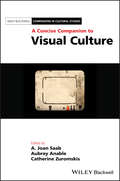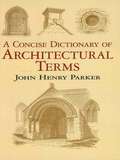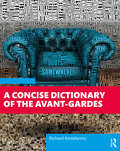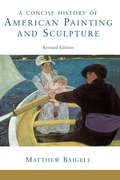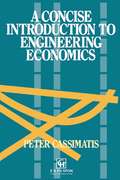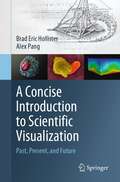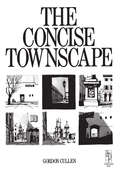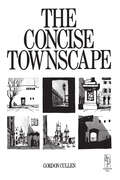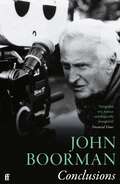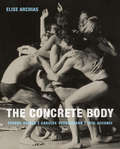- Table View
- List View
A Concise Companion to Visual Culture (Blackwell Companions in Cultural Studies)
by A. Joan Saab Aubrey Anable Catherine ZuromskisProvides an up-to-date overview of the present state Visual Cultural Studies, featuring new original content, topics, and methods The Wiley Blackwell Concise Companion to Visual Culture brings together original research by both established scholars and new voices in the dynamic field, exploring the history, current state, and possible future directions of visual cultural studies. Organized as a series of non-traditional keyword essays, this innovative volume engages readers with a diversity of ideas and perspectives to broaden and enrich their understanding of visual culture and its operations. This accessible, reader-friendly volume begins with a brief introduction to the history and practices of visual studies, featuring interviews and conversations with key figures such as W.J.T. Mitchell and Douglas Crimp. The majority of the text explores key concepts within a broad framework of history, ecologies, mediations, agencies, and politics while placing particular emphasis on interdisciplinarity and intersectionality. Essays cover keyword topics including Identities, Representation, Institutions, Architectures, Memes, Environment, Temporality, and many more. Offering a unique approach to the subject, this timely resource: <li style="margin: 0px 0px 0px 24px; padding: 0px; user-select: text; -webkit-user-drag: none; -webkit-tap-highlight-color: transparent; overflow: visible; cursor: text; clear: both; position: relative; direction: ltr; display: block; f
A Concise Companion to Visual Culture (Blackwell Companions in Cultural Studies)
by A. Joan Saab Aubrey Anable Catherine ZuromskisProvides an up-to-date overview of the present state Visual Cultural Studies, featuring new original content, topics, and methods The Wiley Blackwell Concise Companion to Visual Culture brings together original research by both established scholars and new voices in the dynamic field, exploring the history, current state, and possible future directions of visual cultural studies. Organized as a series of non-traditional keyword essays, this innovative volume engages readers with a diversity of ideas and perspectives to broaden and enrich their understanding of visual culture and its operations. This accessible, reader-friendly volume begins with a brief introduction to the history and practices of visual studies, featuring interviews and conversations with key figures such as W.J.T. Mitchell and Douglas Crimp. The majority of the text explores key concepts within a broad framework of history, ecologies, mediations, agencies, and politics while placing particular emphasis on interdisciplinarity and intersectionality. Essays cover keyword topics including Identities, Representation, Institutions, Architectures, Memes, Environment, Temporality, and many more. Offering a unique approach to the subject, this timely resource: <li style="margin: 0px 0px 0px 24px; padding: 0px; user-select: text; -webkit-user-drag: none; -webkit-tap-highlight-color: transparent; overflow: visible; cursor: text; clear: both; position: relative; direction: ltr; display: block; f
Concise Computer Vision: An Introduction into Theory and Algorithms (Undergraduate Topics in Computer Science)
by Reinhard KletteThis textbook provides an accessible general introduction to the essential topics in computer vision. Classroom-tested programming exercises and review questions are also supplied at the end of each chapter. Features: provides an introduction to the basic notation and mathematical concepts for describing an image and the key concepts for mapping an image into an image; explains the topologic and geometric basics for analysing image regions and distributions of image values and discusses identifying patterns in an image; introduces optic flow for representing dense motion and various topics in sparse motion analysis; describes special approaches for image binarization and segmentation of still images or video frames; examines the basic components of a computer vision system; reviews different techniques for vision-based 3D shape reconstruction; includes a discussion of stereo matchers and the phase-congruency model for image features; presents an introduction into classification and learning.
A Concise Dictionary of Architectural Terms
by John Henry ParkerJohn Henry Parker's remarkably timeless dictionary of architecture, first published in 1846, became such a success that he continued to revise it for several years. A profusely illustrated manual that is valuable as a reference or as a portable guide on visits to historical buildings, this authoritative glossary of nearly 500 words used in Greek, Roman, Italian, and Gothic architecture remains highly instructive and informative.Accurate engravings complement many of the author's incisive descriptions -- from a buttress in Glastonbury Abbey to zig-zag mouldings in a Norman doorway. Extended entries cover arches, windows, tombs, and other architectural elements; while shorter notes define less commonly used terms such as cavetto, dado, and embrasure.An indispensable reference for architects and students of architecture, the text includes a topographical index to the illustrations, identifying the many British cathedrals, castles, and parish churches used as examples.
A Concise Dictionary of the Avant-Gardes: Concise Edition
by Richard KostelanetzFor a concise edition of his legendary arts dictionary of information and opinion, the distinguished critic and arts historian Richard Kostelanetz selects entries from the 2018 third edition. Typically he provides intelligence unavailable anywhere else, no less in print than online, about a wealth of subjects and individuals. Focused upon what is truly innovative and excellent, Kostelanetz also ranges widely with insight and surprise, including appreciations of artistic athletes such as Muhammad Ali and the Harlem Globetrotters and such collective creations as Las Vegas and his native New York City. Continuing the traditions of cheeky high-style Dictionarysts, honoring Ambrose Bierce and Samuel Johnson (both with individual entries), Kostelanetz offers a "reference book" to be enjoyed, not only in bits and chunks but continuously as one of the ten books someone would take if he or she planned to be stranded on a desert isle.
A Concise Dictionary of the Avant-Gardes
by Richard KostelanetzFor a concise edition of his legendary arts dictionary of information and opinion, the distinguished critic and arts historian Richard Kostelanetz selects entries from the 2018 third edition. Typically he provides intelligence unavailable anywhere else, no less in print than online, about a wealth of subjects and individuals. Focused upon what is truly innovative and excellent, Kostelanetz also ranges widely with insight and surprise, including appreciations of artistic athletes such as Muhammad Ali and the Harlem Globetrotters and such collective creations as Las Vegas and his native New York City. Continuing the traditions of cheeky high-style Dictionarysts, honoring Ambrose Bierce and Samuel Johnson (both with individual entries), Kostelanetz offers a "reference book" to be enjoyed, not only in bits and chunks but continuously as one of the ten books someone would take if he or she planned to be stranded on a desert isle.
The Concise Focal Encyclopedia of Photography: From the First Photo on Paper to the Digital Revolution
by Michael R. PeresDefining photography is impossible. Revealing it is another matter, and that's what The Concise Focal Encyclopedia of Photography does,with each turn of the page.History: The technical origins and evolution of photography are half of the story. The other half consists of the ways that cultural forces have transformed photography into a constellation of practices more diverse than any other mode of representation. Photographers can tell a more in-depth story through a photo like Dorothea Lange's "Migrant Mother" than a journalist ever could with the written word alone.Major themes and practitioners: Over 25 entries, many with supporting illustrations,examine the figures, trends, and ideas that have contributed most heavily to the history and current state of photography.Contemporary issues: The issues influencing photography today are more complex than at any other time in its history. Questions of ethics, desire, perception, digitization, and commercialization all vie for attention. Hear what the experts have to say about crucialissues such as whether or not the images we take today will last the test of time, and if so, how?When material is covered this skillfully, "concise" is no compromise. The Concise Focal Encyclopedia of Photography is packed with useful information, compellingideas, and - best of all - pure pleasure.
The Concise Focal Encyclopedia of Photography: From the First Photo on Paper to the Digital Revolution
by Michael R. Peres Mark Osterman Grant B. R Omer Nancy M. Stuart J. Tomas LopezDefining photography is impossible. Revealing it is another matter, and that's what The Concise Focal Encyclopedia of Photography does,with each turn of the page.History: The technical origins and evolution of photography are half of the story. The other half consists of the ways that cultural forces have transformed photography into a constellation of practices more diverse than any other mode of representation. Photographers can tell a more in-depth story through a photo like Dorothea Lange's "Migrant Mother" than a journalist ever could with the written word alone.Major themes and practitioners: Over 25 entries, many with supporting illustrations,examine the figures, trends, and ideas that have contributed most heavily to the history and current state of photography.Contemporary issues: The issues influencing photography today are more complex than at any other time in its history. Questions of ethics, desire, perception, digitization, and commercialization all vie for attention. Hear what the experts have to say about crucialissues such as whether or not the images we take today will last the test of time, and if so, how?When material is covered this skillfully, "concise" is no compromise. The Concise Focal Encyclopedia of Photography is packed with useful information, compellingideas, and - best of all - pure pleasure.
A Concise History Of American Painting And Sculpture: Revised Edition
by Matthew BaigellThis clear, thorough, and reliable survey of American painting and sculpture from colonial times to the present day covers all the major artists and their works, outlines the social and cultural backgrounds of each period, and includes 409 illustrations integrated with the text. Although some determining factors in American art are considered, Matthew Baigell views the rich and diverse achievements of American art as the result of the efforts and talents of a pluralistic society rather than as fitting into a particular mold.This edition includes corrections and revisions to the text, an updated bibliography, and 13 new illustrations.
A Concise History Of American Painting And Sculpture: Revised Edition
by Matthew BaigellThis clear, thorough, and reliable survey of American painting and sculpture from colonial times to the present day covers all the major artists and their works, outlines the social and cultural backgrounds of each period, and includes 409 illustrations integrated with the text. Although some determining factors in American art are considered, Matthew Baigell views the rich and diverse achievements of American art as the result of the efforts and talents of a pluralistic society rather than as fitting into a particular mold.This edition includes corrections and revisions to the text, an updated bibliography, and 13 new illustrations.
A Concise Introduction to Engineering Economics
by P. CassimatisThis comprehensive yet accessible text emphasizes problem solving, evaluation of projects, capital budgeting and resource allocation under risk and uncertainty. Current theory of economics and finance is also discussed andthe text is complemented by a full set of problems, exercises and case studies.
A Concise Introduction to Engineering Economics
by P. CassimatisThis comprehensive yet accessible text emphasizes problem solving, evaluation of projects, capital budgeting and resource allocation under risk and uncertainty. Current theory of economics and finance is also discussed andthe text is complemented by a full set of problems, exercises and case studies.
A Concise Introduction to Hypercomplex Fractals
by Andrzej KatuninThis book presents concisely the full story on complex and hypercomplex fractals, starting from the very first steps in complex dynamics and resulting complex fractal sets, through the generalizations of Julia and Mandelbrot sets on a complex plane and the Holy Grail of the fractal geometry – a 3D Mandelbrot set, and ending with hypercomplex, multicomplex and multihypercomplex fractal sets which are still under consideration of scientists. I tried to write this book in a possibly simple way in order to make it understandable to most people whose math knowledge covers the fundamentals of complex numbers only. Moreover, the book is full of illustrations of generated fractals and stories concerned with great mathematicians, number spaces and related fractals. In the most cases only information required for proper understanding of a nature of a given vector space or a construction of a given fractal set is provided, nevertheless a more advanced reader may treat this book as a fundamental compendium on hypercomplex fractals with references to purely scientific issues like dynamics and stability of hypercomplex systems.
A Concise Introduction to Hypercomplex Fractals
by Andrzej KatuninThis book presents concisely the full story on complex and hypercomplex fractals, starting from the very first steps in complex dynamics and resulting complex fractal sets, through the generalizations of Julia and Mandelbrot sets on a complex plane and the Holy Grail of the fractal geometry – a 3D Mandelbrot set, and ending with hypercomplex, multicomplex and multihypercomplex fractal sets which are still under consideration of scientists. I tried to write this book in a possibly simple way in order to make it understandable to most people whose math knowledge covers the fundamentals of complex numbers only. Moreover, the book is full of illustrations of generated fractals and stories concerned with great mathematicians, number spaces and related fractals. In the most cases only information required for proper understanding of a nature of a given vector space or a construction of a given fractal set is provided, nevertheless a more advanced reader may treat this book as a fundamental compendium on hypercomplex fractals with references to purely scientific issues like dynamics and stability of hypercomplex systems.
A Concise Introduction to Scientific Visualization: Past, Present, and Future
by Brad Eric Hollister Alex PangScientific visualization has always been an integral part of discovery, starting first with simplified drawings of the pre-Enlightenment and progressing to present day. Mathematical formalism often supersedes visual methods, but their use is at the core of the mental process. As historical examples, a spatial description of flow led to electromagnetic theory, and without visualization of crystals, structural chemistry would not exist. With the advent of computer graphics technology, visualization has become a driving force in modern computing. A Concise Introduction to Scientific Visualization – Past, Present, and Future serves as a primer to visualization without assuming prior knowledge. It discusses both the history of visualization in scientific endeavour, and how scientific visualization is currently shaping the progress of science as a multi-disciplinary domain.
Concise Townscape
by Gordon CullenThis book pioneered the concept of townscape. 'Townscape' is the art of giving visual coherence and organization to the jumble of buildings, streets and space that make up the urban environment. It has been a major influence on architects, planners and others concerned with what cities should look like.
Concise Townscape
by Gordon CullenThis book pioneered the concept of townscape. 'Townscape' is the art of giving visual coherence and organization to the jumble of buildings, streets and space that make up the urban environment. It has been a major influence on architects, planners and others concerned with what cities should look like.
Conclusions
by John Boorman'What a life! What a career!' Harold Pinter'Boorman is one of the world's great directors, a master storyteller.' Paul AusterJohn Boorman is one of cinema's authentic visionaries whose travels have taken him from London in the Blitz to the pinnacle of Hollywood success: the man behind filmes such as Point Blank, Deliverance, Excalibur, Hope and Glory, and The General. Conclusions continues the story of his life that Boorman began with Adventures of a Suburban Boyand shares what has happened since its publication: films made (such as the award-winning The General) and unmade; new knowledge about the craft of film-making; and, ultimately, the story of of his kith and kin, including the death of his cherished elder daughter.Wielding a metaphorical Excalibur, Boorman's career has been a continual search for the truth that only art can convey, and this memoir shows him at his finest.
Concorde Pocket Manual (Conway Pocket Manuals Ser.)
by Richard Johnstone-BrydenFirst flown in 1969, Concorde was the first supersonic aircraft to go into commercial service in 1976 and made her final flight in 2003. She was operated primarily by British Airways and Air France. British Airways' Concordes made just under 50,000 flights and flew more than 2.5m passengers supersonically. A typical London to New York crossing would take a little less than three and a half hours compared to around eight hours for a 'subsonic flight'. In November 1986 a Concorde flew around the world, covering 28,238 miles in 29 hours, 59 minutes.Today, Concordes can be viewed at museums across the UK and in France, including at IWM Duxford, Brooklands and Fleet Air Arm Museum, as well as at Heathrow, Manchester and Paris-Orly airports. However, there have been recent reports suggest that a Concorde may start operating commercially again. Through a series of key documents the book tells the story of how the aircraft was designed and developed as well as ground-breaking moments in her commercial history.
Concorde Pocket Manual
by Richard Johnstone-BrydenFirst flown in 1969, Concorde was the first supersonic aircraft to go into commercial service in 1976 and made her final flight in 2003. She was operated primarily by British Airways and Air France. British Airways' Concordes made just under 50,000 flights and flew more than 2.5m passengers supersonically. A typical London to New York crossing would take a little less than three and a half hours compared to around eight hours for a 'subsonic flight'. In November 1986 a Concorde flew around the world, covering 28,238 miles in 29 hours, 59 minutes.Today, Concordes can be viewed at museums across the UK and in France, including at IWM Duxford, Brooklands and Fleet Air Arm Museum, as well as at Heathrow, Manchester and Paris-Orly airports. However, there have been recent reports suggest that a Concorde may start operating commercially again. Through a series of key documents the book tells the story of how the aircraft was designed and developed as well as ground-breaking moments in her commercial history.
The Concrete Body: Yvonne Rainer, Carolee Schneemann, Vito Acconci
by Elise ArchiasOffering an incisive rejoinder to traditional histories of modernism and postmodernism, this original book examines the 1960s performance work of three New York artists who adapted modernist approaches to form for the medium of the human body. Finding parallels between the tactility of a drip of paint and a body’s reflexive movements, Elise Archias argues convincingly that Yvonne Rainer (b. 1934), Carolee Schneemann (b. 1939), and Vito Acconci (b. 1940) forged a dialogue between modernist aesthetics and their own artistic community’s embrace of all things ordinary through work that explored the abstraction born of the body’s materiality. Rainer’s task-like dances, Schneemann’s sensuous appropriations of popular entertainment, and Acconci’s behaviorist-inflected tests highlight the body’s unintended movements as vital reminders of embodied struggle amid the constraining structures in contemporary culture. Archias also draws compelling comparisons between embodiment as performed in the work of these three artists and in the sit-ins and other nonviolent protests of the era.
Concrete Century: Julius Kahn and the Construction Revolution
by Michael G SmithAt the turn of the 20th century, industrial manufacturing was expanding dramatically while factory buildings remained fire-prone relics of an earlier age. That is, until a 28-year-old civil engineer finally achieved what engineers around the world had unsuccessfully attempted. Working in his brother’s basement in Detroit, Julius Kahn invented the first practical and scientific method of reinforcing concrete with steel bars, which finally made it possible to construct strong, fireproof buildings. After Kahn founded a company in 1903 to manufacture and sell his reinforcement bars, his system of construction became the most widely used throughout the world. Drawing upon Kahn’s personal correspondence, architectural drawings, company records, and contemporary news and journal articles, Michael G. Smith reveals how this man—whose family had immigrated to the US to escape antisemitism in Germany—played an important role in the rise of concrete. Concrete not only turned the tide against widespread destruction of buildings by fire, it also paved the way for our modern economy. Concrete Century will delight readers intrigued by architecture and construction technology alike with the true origin story of modern concrete buildings.
Concrete Design (Architect's Guidebooks to Structures)
by Paul W. McMullin Jonathan S. Price Esra Hasanbas PersellinConcrete Design covers concrete design fundamentals for architects and engineers, such as tension, flexural, shear, and compression elements, anchorage, lateral design, and footings. As part of the Architect’s Guidebooks to Structures Series it provides a comprehensive overview using both imperial and metric units of measurement. Written by experienced professional structural engineers Concrete Design is beautifully illustrated, with more than 170 black and white images, contains clear examples that show all design steps, and provides rules of thumb and simple tables for initial sizing. A refreshing change in textbooks for architectural materials courses, it is an indispensable reference for practicing architects and students alike. As a compact summary of key ideas it is ideal for anyone needing a quick guide to concrete design.
Concrete Design (Architect's Guidebooks to Structures)
by Paul W. McMullin Jonathan S. Price Esra Hasanbas PersellinConcrete Design covers concrete design fundamentals for architects and engineers, such as tension, flexural, shear, and compression elements, anchorage, lateral design, and footings. As part of the Architect’s Guidebooks to Structures Series it provides a comprehensive overview using both imperial and metric units of measurement. Written by experienced professional structural engineers Concrete Design is beautifully illustrated, with more than 170 black and white images, contains clear examples that show all design steps, and provides rules of thumb and simple tables for initial sizing. A refreshing change in textbooks for architectural materials courses, it is an indispensable reference for practicing architects and students alike. As a compact summary of key ideas it is ideal for anyone needing a quick guide to concrete design.
Concrete Petrography: A Handbook of Investigative Techniques, Second Edition
by ALAN B. POOLE; IAN SIMSThis classic reference has established the value of petrography as a powerful method for the investigation of concrete as a material. It provides an authoritative and well-illustrated review of concrete composition and textures, including the causes of defects, deterioration, and failure that can be identified using a petrological microscope. This new edition is entirely revised and updated and also greatly extended to take account of new scientific developments and significant improvements in instrumentation and to reflect current laboratory working practices, as well as to reflect new understanding of the performance of concrete and related materials. Now in full color throughout, Concrete Petrography, Second Edition provides case study examples, with appropriate explanatory discussions and practical advice on selecting, handling and preparing specimens. It assists and guides the engineer, the trainee and the experienced petrographer in understanding the scientific evidence that is basic to petrographic analysis and so will lead to more accurate and timely diagnosis and treatment of problems in structural concrete. This book includes: Contributions in specialist areas by internationally recognized experts Explanation of computer techniques as an aid to petrography Full coverage of inspection, sampling, and specimen preparation New sections covering recent technological development of equipment Guidance on observation of cement and concrete mineralogy and microfabrics Discussion and illustrative examples of deterioration and failure mechanisms New work and guidance on the determination of water/cement ratio New color illustrations and micrographs throughout Thorough updating of standards, other authoritative publications, and references A fully revised, extended, and updated glossary of optical and other properties
